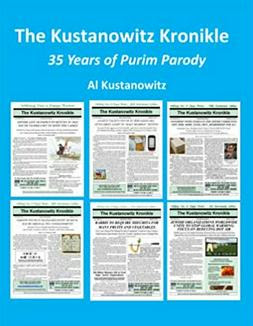 |
| Photo: Moshe Silberhaft |
Last week we posted a story about a tombstone that appeared in a British sitcom with Hebrew lettering that was backwards and inadvertently stated that the occupant of the grave was "pickled at great expense."
Now comes a kindred story far removed in time and space that was published yesterday in the Washington Jewish Week. It seems that in the country of Namibia, formerly called Southwest Africa, there is a tombstone in a cemetery in the capital city of Windhoek that once was engraved with the Hebrew words "Kosher L'Pesach" upside down.
This has been a sort of urban legend for the last few decades, with various versions appearing on the internet, sharing the basic story line but with conflicting details such as the name of the man who was described as Kosher L'Pesach. But out of the mists of history the true story has finally come out, thanks to Harvey Leifert, who served at the American embassy in Namibia twenty years ago, and who wrote the article in the Washington Jewish Week.
As Leifert reported yesterday in the paper,
The Jewish community was small when I lived in Windhoek, and has dwindled since, but some Jews have always lived far from the capital, in small towns and on farms. One such person was Walter Galler, a resident of Swakopmund, then a small German port on the Atlantic, up the coast from the larger and better situated British port of Walvis Bay. We know little of Galler, who was born on Aug. 8, 1888, and died on Sept. 28, 1939.
Photo: Moshe Silberhaft
Galler was married to a non-Jewish "colored," or mixed-race, woman, and when he died, the story goes, his widow arranged for a Jewish burial in the Swakopmund Cemetery, on the edge of the Namib Desert. Mrs. Galler then ordered a simple tombstone to mark her husband's grave, and she felt it must include an acknowledgement of his Jewish faith. She somehow knew that a Hebrew inscription was appropriate, but the only Hebrew text in her home was the certification "kasher l'Pesach," found, along with a Star of David, on the label of a bottle of wine.
Mrs. Galler apparently cut out the Hebrew words and star and handed them to the stone mason. He chiseled the letters into the tombstone, but, not knowing the Hebrew alphabet, he inscribed them upside down.
There the story might have ended, but decades later, word of a "kasher l'Pesach" tombstone in a far-off cemetery was circulating in Windhoek's Jewish community. Almost uniformly, from what I have heard, members praised Mrs. Galler for making an effort to recognize and respect her late husband's religion, regardless of the, er, unorthodox result. One day in the 1970s, however, a visiting rabbi from neighboring South Africa drove to Swakopmund and inspected the grave. He determined that the upside-down Hebrew inscription must go, and so it was done. The Star of David remains, now flanked by two blank rectangles.
But, why was the inscription excised? According to Rabbi Moshe Silberhaft, the current country communities rabbi, who was not involved in the decision, "the reason it was removed is that the gravesite was becoming a tourist attraction, and it was felt that it was 'unsettling' and disrespectful for the deceased."
Over the years, Swakopmund developed into a lovely seaside resort town, attracting both Namibian and foreign visitors. Some still find their way to the local cemetery and leave a pebble on the grave that once was kosher for Pesach.















Considering how hard, long & carefully I work to prepare for Pesach every year, I would consider it perfectly just and appropriate to have Kosher l'Pesach written on my tombstone!
ReplyDeleteבושה מה משהרבי הזה עשה!
ReplyDeleteCan you share me the present image of this Kosher L'Pesach Tombstone?
ReplyDeleteOn reading this post I feel very excited. I want to know more about this Tombstone in Namibia.
ReplyDelete